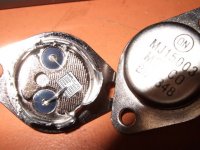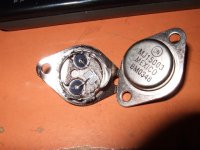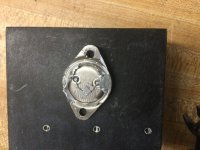Beware because some fakes can be a bit tough to detect/verify. For example I bought some ultra low noise regulators and then I noticed that the bypass pin was open circuit. They worked as regulators but were not low noise. They were just a cheap regulator marked as a much more expensive model. They also burned at lower input voltages than they should have.
I would check carefully to make sure they are the right current rating (not smaller lower current regulator dies) and have the correct input voltage range capability. Hopefully they are not LM317L type or AMS1117 type in a TO-220 package. (Like all the fake power transistors which are small cheap die inside a large package.)
Partially functional fakes are a pain. Like all the 4558 and TL082 type op-amps marked and sold as all kinds of expensive op-amps.
I would check carefully to make sure they are the right current rating (not smaller lower current regulator dies) and have the correct input voltage range capability. Hopefully they are not LM317L type or AMS1117 type in a TO-220 package. (Like all the fake power transistors which are small cheap die inside a large package.)
Partially functional fakes are a pain. Like all the 4558 and TL082 type op-amps marked and sold as all kinds of expensive op-amps.
Last edited:
A quick test is with an input just a few volts above nominal output, load it up to find the current limit. This will find 0.5 A or even 100 mA die being sold as 1 A parts and copies that don't even have a current limit
Can a curve tracer (like the one you are working on) be used to identify fakes by comparing measurements with datasheets?Beware because some fakes can be a bit tough to detect/verify.
(Like all the fake power transistors which are small cheap die inside a large package.)
Partially functional fakes are a pain. Like all the 4558 and TL082 type op-amps marked and sold as all kinds of expensive op-amps.
That is tough. I think in some cases yes. A few years back I worked on one that had a huge power supply and low ESR reservoir capacitor so that I could make (pulsed) measurements out to many amps. That combined with capacitance measurements was pretty useful. Comparing curves in the right regions with a good reference device is helpful but do you really want to do that much work? I am working on my curve tracer out of interest plus the fact that I have a number of bags of 100-200 each of quite a few parts numbers. Some seem to be quite reasonable generics. Others (such as the 2SD669) turned out to be fakes made with unsuitably small die.
Honestly when it takes expensive equipment to test the fakes it is perhaps best to switch to authorized distributors. The generic 2SA970 that I am testing right now look very very close to the Toshiba datasheet curves. But I suspect that they are slightly higher capacitance which I will look at later. So the IV curves alone with my curve tracer might not be enough in that example. Those were sold as generics with no attempt to pretend they were Toshiba parts.
For the op-amps I use an LNA and a CS4398 DAC to test for fake op-amps. I have also built a 1kHz Hall notch filter. But I build much of this mainly because it is interesting to me. The combined noise of my reference, LNA and real OPA1612 measure at 1.5nV/rtHz so I can measure pretty low. Noise gives away many fake op-amps, along with input bias current, offset voltage, Iq and (of course) distortion.
Honestly when it takes expensive equipment to test the fakes it is perhaps best to switch to authorized distributors. The generic 2SA970 that I am testing right now look very very close to the Toshiba datasheet curves. But I suspect that they are slightly higher capacitance which I will look at later. So the IV curves alone with my curve tracer might not be enough in that example. Those were sold as generics with no attempt to pretend they were Toshiba parts.
For the op-amps I use an LNA and a CS4398 DAC to test for fake op-amps. I have also built a 1kHz Hall notch filter. But I build much of this mainly because it is interesting to me. The combined noise of my reference, LNA and real OPA1612 measure at 1.5nV/rtHz so I can measure pretty low. Noise gives away many fake op-amps, along with input bias current, offset voltage, Iq and (of course) distortion.
Last edited:
Hi kozard,
Sometimes you can tell with capacitance measurements, but when you are looking at noise tests you are into test fixturing and expensive test setups. Never mind the investment in time.
-Chris
Exactly what I have been saying for years.Honestly when it takes expensive equipment to test the fakes it is perhaps best to switch to authorized distributors.
Sometimes you can tell with capacitance measurements, but when you are looking at noise tests you are into test fixturing and expensive test setups. Never mind the investment in time.
-Chris
That is the distinction between fakes vs copies (duplicates). By measuring parameters and response curves you can make good judgements to decide if they are fakes (re-labelled cheap devices). You are right in that if you can get the parts from authorized dealers there is no need to do any of that.Honestly when it takes expensive equipment to test the fakes it is perhaps best to switch to authorized distributors. The generic 2SA970 that I am testing right now look very very close to the Toshiba datasheet curves. But I suspect that they are slightly higher capacitance which I will look at later. So the IV curves alone with my curve tracer might not be enough in that example. Those were sold as generics with no attempt to pretend they were Toshiba parts.
.
These are currently on offer on Fleabay.
Anyone spot the error ??
ARE THEY GENUINE ?
.Matched Quad 405 Replacement 2n3773 Transistors,best quality ever | eBay
Andy
Late to the party as usual, but I actually have a unused pair of Tesla branded 2N3773, and probably a dozen Magnatec
Seen the price of Phillip's T03s? Maybe I should sell all the BUS14 and BUX I have saved for a rainy day?
Hahaha I will have to check....
But to be honest, given the weight and general heft of the to3 package, and oversize gauge pins that these Tesla, and the Phillip's BUS make me believe these are genuine.
If I recall they came from Rochester over a decade ago, but my memory fails.
I do have "other" Phillips and Magnatec 2N3773 2N3055 etc that I believe some are fakes (and those were bought from a similarly vast broker, but for a repair at work)
Interestingly (perhaps), I have had a nightmare sourcing some obsolete devices that I need for work.
No option in the end, but to go to eBay and take the risk.
Things like BC183L, 214L, OP10Y (ceramic), LH0041CG.
Ever try and source a PAD50 picoAmp diode recently?
Everything, looks very genuine, so far. And bought for Far cheaper than a "trusted" semis broker.
But to be honest, given the weight and general heft of the to3 package, and oversize gauge pins that these Tesla, and the Phillip's BUS make me believe these are genuine.
If I recall they came from Rochester over a decade ago, but my memory fails.
I do have "other" Phillips and Magnatec 2N3773 2N3055 etc that I believe some are fakes (and those were bought from a similarly vast broker, but for a repair at work)
Interestingly (perhaps), I have had a nightmare sourcing some obsolete devices that I need for work.
No option in the end, but to go to eBay and take the risk.
Things like BC183L, 214L, OP10Y (ceramic), LH0041CG.
Ever try and source a PAD50 picoAmp diode recently?
Everything, looks very genuine, so far. And bought for Far cheaper than a "trusted" semis broker.
Last edited:
different factories can also have different stamps and different surface textures of the respective power devices.Hi.I have found this on a local store a few hundred pcs. Are they genuine?Regards
It is not possible to deduce from this alone, whether it is counterfeit or not.
I would ask here (maybe sending images of this parts or sending a sample one of these MJ parts itself):
Contact Us at ON Semiconductor
One ought to know best there.
Last edited:
Does anyone know about Motorola date codes for to92 jfets?
I'd be interested in knowing more about manufacturers date codes, but I'm finding the information hard to.come by.
Can anyone help here?
I'd be interested in knowing more about manufacturers date codes, but I'm finding the information hard to.come by.
Can anyone help here?
The actual data sheet normally give a description of the date code and what it means, but not the actual production run dates.
Thanks, and true enough.
Although I can only find a single page extract from the Motorola small signal data book, which does not show it - or download the entire Motorola data book.
Although I can only find a single page extract from the Motorola small signal data book, which does not show it - or download the entire Motorola data book.
Date codes by a manufacturer should all be the same. Close enough to make sense out of. Just look up a similar device in production at the time an go from there.
These are genuine samples delivered from OmiSemi about 15 years ago
2N5631 (Motorola) from the Way Back Machine. Anything look familiar?
Attachments
Short update to the LM337: Seems to be genuine, works within normal fashion so far. I only did a short test though because of lack of a fitting heatsink and I didn't want to start drilling and tapping on a new one. Thanks for your answers!
They normally burn a smaller hole in the top cover when grossly overloaded!2N5631 (Motorola) from the Way Back Machine. Anything look familiar?
But really, you can see how well the top cover is attached. That one did go quietly.
-Chris
That one actually still worked. It was a pull from a PCB, with the leads trimmed too short to use with a heat sink. So it was expendable. It is just sitting on a black heat sink for contrast in the photo.
The die inside is exactly the same as that 15003. Test conditions are different, and some guaranteed ratings, but it’s really the same part. What really struck me as odd was the one fake MJ15024 I’ve run into that had that same die inside. I wonder where the Chinese got *that*.
Those old aluminum case are harder to get apart than the steel ones (even real ones). They all require some cutting. I’ve never run into a fake aluminum TO-3 yet. I guess the fakes just weren’t common in the 80’s. Which is good, because I couldn’t afford full price for power transistors back then.
The die inside is exactly the same as that 15003. Test conditions are different, and some guaranteed ratings, but it’s really the same part. What really struck me as odd was the one fake MJ15024 I’ve run into that had that same die inside. I wonder where the Chinese got *that*.
Those old aluminum case are harder to get apart than the steel ones (even real ones). They all require some cutting. I’ve never run into a fake aluminum TO-3 yet. I guess the fakes just weren’t common in the 80’s. Which is good, because I couldn’t afford full price for power transistors back then.
- Home
- Design & Build
- Parts
- My Transistors, original or copy?


